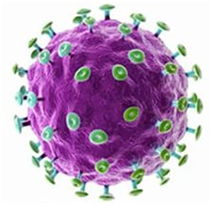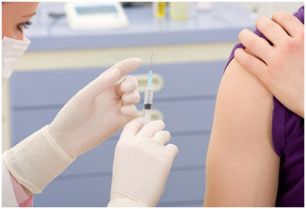
The human papilloma virus (hpv) is a major cause of morbidity and mortality throughout the world. Today it is one of the most common sexually transmitted virus. The threat of virus infection of the exposed large part of the population of different ages.
One out of every ten people on the planet are infected with this virus.
Some types of diseases related to the hpv negative in the reproductive function of the woman. It is celebrated in the mass of the identification of new cases of cancer of the female reproductive system, related to infection by human papillomavirus (hpv.
Of the story.
The lesions of the skin and mucous membranes are known to mankind since more than a millennium. Under the name of "warts" they were described by the physicians of Ancient greece. The special relevance of the infection was acquired at the end of the twentieth century. The viral nature of warts it has been shown that at the beginning of the last century, about the sexual relationship of the transmission path of the infection reported in 1954
The frequency of condylomatosis among young people and middle-aged:
- 1981-1986 is - 5.4 per cent
- 1987-1999 is - 19,1%
- now - up to 60%.
What is human papillomavirus infection?
The human papillomavirus infection - the chronic disease of the viral disease, transmitted from person to person by sexual contact.
The causative agent of the infection.
The causative agent of the disease is the human papilloma virus (hpv) is a common name for more than 80 types of viruses that cause various diseases of the skin and the mucous membranes of the body. Each one of the viruses of the group of hpv has a sequence number.

The human papilloma virus is discovered:
- in the skin
- the mucous membranes of the oral cavity
- the mucous membranes of the conjunctiva
- the mucosa of the esophagus
- the mucosa of the bronchi, larynx
- the mucosa of the rectum
- the mucosa of the genital organs
The transmission of the virus.
The transmission of the virus occurs only from person to person. The main route of transmission is sexual.
It can also be produced:
- contact-apparatus transmission route of the infection when there is the UN epithelium - the virus can penetrate the human body through scratches and abrasion, the virus of an infected person remains in the bath of steam, gym, swimming pool, towel, razor
- the medical staff can become infected with the inhalation of dust at the time of laser removal of genital warts, become infected through surgical instruments
- transmission from mother to child during pregnancy
The factors that contribute to the onset or recurrence hpv:
- The subcool
- Hormonal disorders
- Medical manipulation (abortion, the introduction of intrauterine devices)
- Pregnancy
The group of hpv infections
- The hpv do not cause cancer (warts on the skin epidermis)
- Hpv of low risk of development of cancer (different types of condylomata genital)
- high-risk carcinogen (tumor of the disease in men and women)
The prevalence of hpv-associated diseases all over the world
- 21 000 - Cancer of the vulva and vagina (in women)
- 40 000 - Anal cancer (Among men)
- 60 000 - Anal cancer (Among women)
- 530 000 - Cancer of neck of uterus (in women)
- 17 300 000 - condyloma Acuminatum (Among men)
- 14 700 000 - condyloma Acuminatum (Among women)
The incubation period of the infection by human papilloma virus can last for 2 months before 2-10 years of age, the average is 3 months.
For human papillomavirus infection characteristic of the hidden stream.
The clinical picture.
During an infection diverse. It may disappear spontaneously, and then re-progress.
Distinguish 3 forms of evolution of the disease:
- clinic - visible papillomas
- are subclinical - the lack of visible manifestation, asymptomatic for revealed only when complementary to the survey (colposcopy or the study of cells)
- latent - is defined only by the analysis of blood
The main symptoms of the human papillomavirus infection is the appearance of:
- warts;
- papillomas - soft tumors, which are attached to the skin, thanks to the leg;
- genital warts - warts with a rough surface (most of which appear around the anus and genitals).
In the case of these symptoms, you should call the attention in the first place.
Consequences of the infection of the human papillomavirus:
- The cervical cancer is in second place in the list of causes of mortality of women. The life expectancy of affected women is reduced by an average of 26 years. It has been shown that 70% of cases of cervical cancer caused by hpv 16 and 18 types.
- The cancer of neck of uterus - entirely preventable disease, if detected in an early stage of the cancer or the stage of precancerous lesions.
- Cancer of the vulva and of the vagina.
- Cancer anal. Each year there are around 100,000 cases of this type of cancer.
- Cancer of the penis. It is called in 35% of cases of hpv 16 and 18, hpv 6 and 11-5% of the cases.
- Anogenital warts. It is called the hpv 6 and 11. According to who, every year in the world recorded more than 30 million cases of sexually transmitted disease warts.
- Cancer oropharyngeal the area of young people.
As to determine the presence of the virus in the body and of what type?

In the majority of cases the infection is asymptomatic, thus the virus in the patient generally only revealed through an analysis.
The diagnosis of hpv can include:
- clinical examination of the patient;
- an examination of the neck of the uterus;
- Polymerase chain reaction (pcr) is an effective method of diagnosis, by which you can determine the type of virus;
- cytologic screening - under the microscope, we studied the nature of the cells (test to cytology of neck of uterus);
- a blood test to detect antibodies against hpv (this method is used very rarely);
- biopsy - during the procedure of diagnosis of "a place" (for example, condylomata, or papillomas) take the tissue particles. Is assigned if it is suspected that the patient has the services of oncology of the disease.
What is the test of the pap smear?
This is a test by which we can determine the precancerous or cancer cells of the vagina and the cervix. With the surface of the neck of the uterus or of the special channel of the spatula, a cotton swab. Extracted material is placed in the glass and sent to a laboratory, where lab technicians will carefully study the cellular structure. Test the name of the Greek scientist Georgios papanicolaou.

When and who should perform the Pap test?
- Cytological smears should be done every woman at least once a year from age 18 or start of sex life. In the case of the lack of sexual relations, the realization of a valid analysis 1 time per 3 years.
- Two times a year in cytological smears is recommended when using a hormonal contraceptive, as well as to women who suffer from genital herpes.
- The reason more and more frequent, the research cytologic are the frequent change of the woman in the sexual partner, the excess of weight (obesity), infertility, the presence of genital warts to the genitals.
The prevention of human papillomavirus infection.
Taking into account the particular risk of this particular infection, the lack of effectiveness of existing treatments, of paramount importance to the prevention of this infectious disease.
Without the prevention:
- the sex education for adolescents
- the limitation of the number of sexual partners
- the use of the condom reduces the risk of transmission of hpv
- cervical screening, which represents the routine screening of women with Pap test smear of the cervix) for the timely detection and treatment of the pathology
- quit smoking
Specific prevention:

Vaccination against the most dangerous (oncogenic) types of hpv for girls and boys at age of 12-13 years until the beginning of the sexual life and the potential contact with hpv. After the vaccination resistant form of immunity.
Why is it necessary to vaccine against human papillomavirus infection?
Human papilloma Virus causes malicious rebirth of cells, that is to say, are the cause of cancer, in particular cancer of neck of uterus.
In recent years there is a rapid growth of the frequency of genital cancers in men, due to which increasingly raises the question of the introduction of the hpv vaccination of the representatives of both sexes.
At present, vaccination against hpv is included in the calendar of vaccinations in 57 countries around the world, six of them are introduced the vaccination of both sexes.
The effectiveness of vaccination reaches 98-100%, which was proven by clinical studies.
The hpv vaccination is most effective before the beginning of the sexual life, but it is recommended that all women of young age.
The introduction of the scale vaccination will prevent up to 80 and 82% of all the tumors of this group.
The prevention of infection with human papillomavirus (hpv) is one of the essential components of the prevention of cervical cancer in women and some types of cancer in men.























